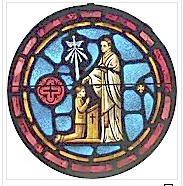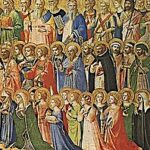Illustration: Stained glass representation of Lutheran Confirmation
Cycle of Catechesis. The Spirit and the Bride. 11
The Holy Spirit leads God’s the people to Jesus our hope.Saint Peter’s Square – Wednesday, 30 October 2024
‘He has anointed us and imprinted us with the seal’
Confirmation, Sacrament of the Holy Spirit
Acts 8:14-17
Now, when the apostles at Jerusalem heard that Samaria had accepted the word of God, they sent Peter and John to them.
The two went down and prayed for them that they might receive the Holy Spirit: for it had not yet come on any of them, but they had only been baptized in the name of the Lord, Jesus. Then Peter and John laid their hands on them and they received the Holy Spirit
Dear Brothers and Sisters,
Today we continue our reflection on the presence and action of the Holy Spirit in the life of the Church through the sacraments.
The sanctifying action of the Holy Spirit comes to us. first of all. through two channels: the Word of God and the sacraments.
And among all the sacraments, there is one which is, par excellence, the sacrament of the Holy Spirit, and it is on this that I would like to dwell today. This is the Sacrament of Confirmation.
In the New Testament, in addition to baptism with water, another rite is mentioned, that of the laying on of hands, which has the purpose of communicating the Holy Spirit visibly and charismatically, with effects similar to those produced on the Apostles at Pentecost.
The Acts of the Apostles refer to a significant episode in this regard.
When they learned that some people in Samaria had received God’s word, they sent Peter and John from Jerusalem. The text says “They went down and prayed for them to receive the Holy Spirit; for he had not yet descended upon any of them but had only been baptized in the name of the Lord Jesus. Then they laid their hands on them, and they received the Holy Spirit“
Added to this is what St. Paul writes in the Second Letter to the Corinthians: “It is God himself who confirms us, together with you, in Christ, and has anointed us, imprinted us with the seal and given us the indwelling of the Spirit in our hearts’.” (1 Cor 1:21-22). The downpayment of the Spirit. The theme of the Holy Spirit as the “royal seal”, with which Christ marks his sheep, is the basis of the doctrine of the “indelible character” conferred by this rite.
With the passage of time, the rite of anointing took shape as a sacrament in its own right, assuming different forms and contents in the various epochs and in the different rites of the Church.
This is not the place to retrace this very complex history.
What the Sacrament of Confirmation is in the Church’s understanding, it seems to me, is described, simply and clearly, by the Catechism for Adults of the Italian Bishops’ Conference.
It says: ‘Confirmation is for each member of the faithful what Pentecost was for the whole Church. […]
It strengthens the baptismal incorporation into Christ and the Church and the consecration to the prophetic, royal and priestly mission.
It communicates the abundance of the gifts of the Spirit […].
Therefore, if baptism is the sacrament of birth, confirmation is the sacrament of growth.
For this reason, it is also the sacrament of witness, because this is closely linked to the maturity of Christian existence.
The problem is how to ensure that the Sacrament of Confirmation is not reduced, in practice, to a “lasts rites”, that is, to the sacrament of “departure” from the Church.
It is said that it is the “sacrament of farewell”, because once the young people do it they leave, and they will then return for marriage.
So people say. But we must make sure that it is the sacrament of the beginning of an active participation in the life of the Church. It is a goal that may seem impossible to us given the situation taking place throughout the Church, but we must not stop pursuing it. It will not be the case for all confirmands, children or adults, but it is important that it is at least for some who will then be the animators of the community.
To this end, it can be useful to be helped in preparing for the sacrament by lay faithful who have had a personal encounter with Christ and have had a true experience of the Spirit.
Some people say that they have experienced it as a blossoming in them of the Sacrament of Confirmation received as children.
But this does not only concern future confirmands; it concerns all of us at all times.
Together with confirmation and anointing, we have also received, the Apostle (Paul) assured us, the pledge of the Spirit whom elsewhere he calls “the first fruits of the Spirit” (Rom 8:23 – and not only the creation, but we ourselves, who have the first fruits of the Spirit, groan inwardly as we wait for adoption as sons, the redemption of our bodies).
We must “spend” this deposit, taste these first fruits, not bury the charisms and talents received in the ground.
Saint Paul exhorted his disciple Timothy to “rekindle the gift of God received through the laying on of hands” (2 Tim 1:6, and the verb used suggests the image of one who blows on the fire to rekindle its flame.
This is a beautiful ‘goal’ for the Jubilee Year!
To remove the ashes of habit and disengagement, to become, like the torchbearers at the Olympics, bearers of the flame of the Spirit. May the Spirit help us to take a few steps in this direction!


